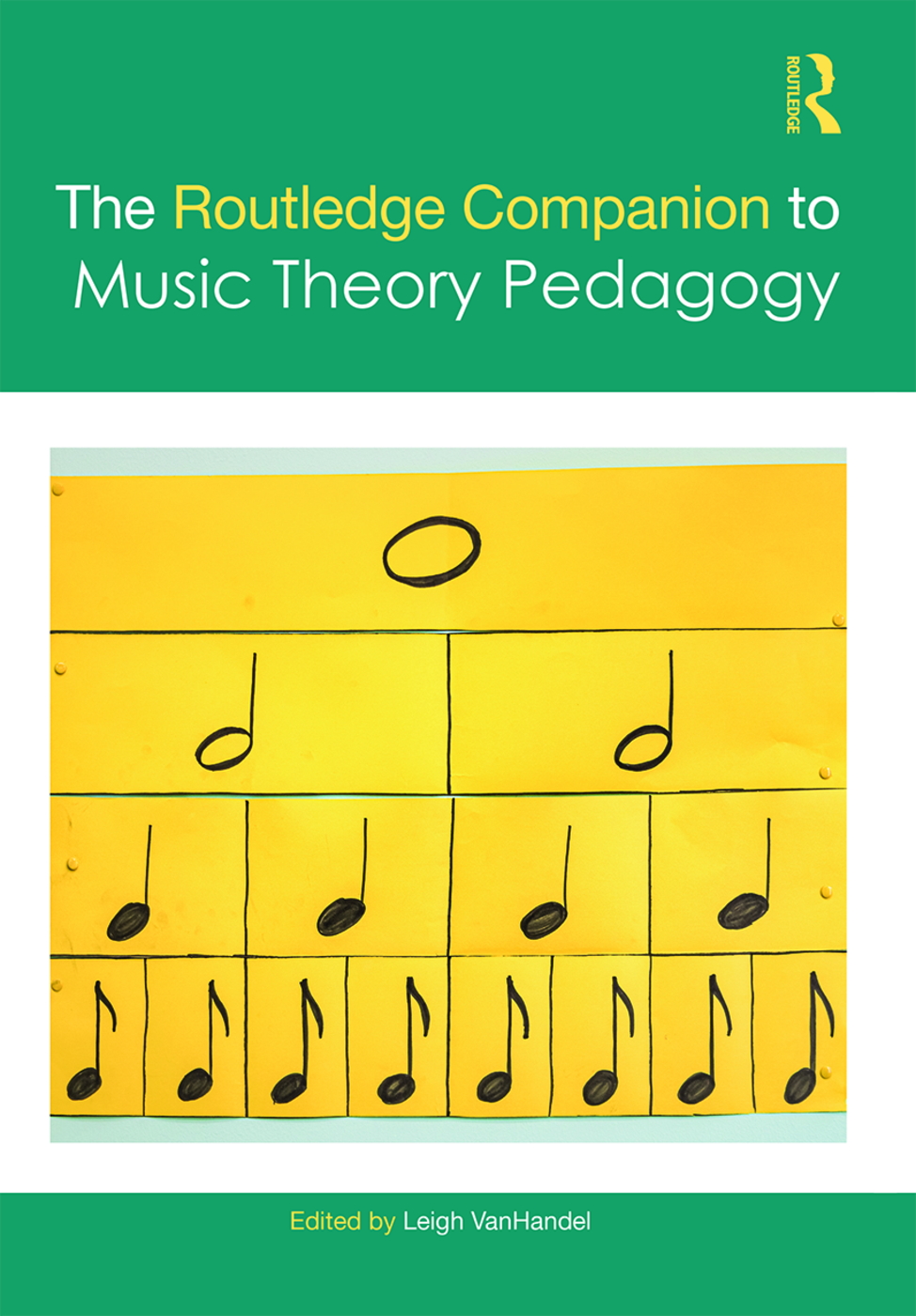Click on a chapter title to download the chapter’s Supplemental Material from Dropbox. (Chapters without links do not have any Supplemental Materials.)
Part I Fundamentals
1. Music Theory and Working Memory
Leigh VanHandel
2. Putting the Music in “Music Fundamentals”
Melissa Hoag
3. A Cornucopia of Accidentals
Paula J. Telesco
4. Contouring as a Powerful Tool for Pitch Awareness
Jan Miyake
5. Incorporating Melodicas Into the Music Theory Classroom
Chelsey L. Hamm
6. Music Fundamentals Games
Stefanie Dickinson
Part II Rhythm and Meter
7. Introducing Musical Meter Through Perception
Stanley V. Kleppinger
8. Starting from Scratch: Representing Meter Using Simple Programming Tools
Daniel B. Stevens
9. “Computer Programmed with Just One Finger”: Transcribing Rap Beats with the Roland TR-808
Michael Berry
10. Rebeaming Rhythms: Helping Students “Feel” the Need for Correct Beaming
Gene S. Trantham
11. Clapping for Credit: A Pedagogical Application of Reich’s Clapping Music
Jon Kochavi
12. Hindustani Tāl: Non-Western Explorations of Meter
Anjni H. Amin
Part III Core Curriculum
Diatonic Harmony
13. Small-Scale Improvisation in the Music Theory Classroom
Nancy Rogers
14. The Cognitive and Communicative Constraints of Part-Writing
Daniel Shanahan
15. Voice-Leading Detectives
Meghan Naxer
16. Harmonic Sequences Simplified: The First Week of Instruction
Brent Auerbach
17. Grading the Song
Michael Baker
18. Finding the Implied Polyphony in the Minuet II from Bach’s Cello Suite No. 1 in G Major
Edward Klorman
Chromatic Harmony
19. Using Tendency Tones to Teach the Morphology and Syntax of Chromatic Harmony
Stacey Davis
20. Apply Yourself! An Active Learning Lesson Plan for Introducing Secondary Dominants
Patricia Burt
21. Plot Twists: Narrative Pivots and the Enharmonic Augmented-Sixth Chord
Jena Root
22. Chromatic Mediants Through the Context of Film Music
Erik Heine
23. How to Analyze Chromatic Lament-Bass Harmonizations (Without Tears)
Jason Britton
24. Introduction to Common-Tone Diminished-Seventh Chords
Nicole Biamonte
25. “It’s an N, bro”: Teaching Enharmonic Reinterpretation of Fully Diminished Seventh Chords by Ear
David Heetderks
Part IV Aural Skills
26. Defending the Straw Man: Modulation, Solmization, and What to Do with a Brain
Gary S. Karpinski
27. Speaking Music
Justin Mariner and Peter Schubert
28. Finding Your Way Home: Methods for Finding Tonic
Tim Chenette
29. Error Detection in Aural Skills Classes
Alexandrea Jonker
Note: early printings of the book had an error where Figure 29.1 was printed incorrectly. The correct Figure 29.1 is available in the supplemental materials.
30. In Search of Hidden Treasures: An Exercise in Symphonic Hearing
Daniel B. Stevens
31. An Aural Skills Introduction to Twelve-Tone Music: Dallapiccola’s “Vespro, Tutto Riporti”
David Geary
Part V Post-Tonal Theory
32. Setting Sets Aside: Prioritizing Motive, Text, and Diversity in Post-Tonal Analysis Courses
Michael Buchler
33. Teaching and Learning Early Twentieth-Century Techniques at the Keyboard
Lynnsey J. Lambrecht
34. Starting the Twentieth Century with a Bang! A Lesson Plan for Whole-Tone Scales in Tosca
Christopher Doll
35. Twentieth-Century Polymodality: Scalar Layering, Chromatic Mismatch, and Symmetry
José Oliveira Martins
36. Twelve-Tone Study Using Symbols in Dallapiccola’s “Fregi,” from Quaderno Musicale di Annalibera
Joe Argentino
37. Integral Serialism: Analysis of Gerhard, String Quartet No. 1, mvt. 3
Rachel Mann
38. Mapping Symmetry and Form in George Crumb’s A Prophecy of Nostradamus
Natalie Williams
Part VI Form
39. Principles of Form
Áine Heneghan
40. Recomposing Phrase Structure
Eric Hogrefe
41. Teaching Musical Structure through Disney Songs
Andrew Vagts and Douglas Donley
42. From Theory to Practice: How to Compose a Sentence
Andrew Schartmann
43. Incorporating Latin-American Popular Music in the Study of Musical Form
Gabriel Navia and Gabriel Ferrão Moreira
44. Binary Form through the Music of Underrepresented Composers
Victoria Malawey
45. A Form-Functional Approach to Binary Form Analysis
Andreas Metz
46. Exploring Ternary Form through the Lens of Analysis-Performance in a Mozart Aria
Elizabeth West Marvin
47. Sonata-Allegro Form: Understanding the Drama
Tom Childs
48. Concerto Form: Transforming a Sonata into a Concerto
Patrick Johnson
Part VII Popular Music
49. Popular Music in the Classroom
John Covach
50. The Beatles’ “Day Tripper”: A Tortured Stretching of the Twelve-Bar Blues
Walter Everett
51. Making Borrowed Chords ‘Pop’: Teaching Modal Mixture through Popular Music
Joshua Albrecht
52. Chromatic Mediants in Popular Music
Victoria Malawey
Part VIII Who, What, and How We Teach
53. Challenges and Opportunities of Teaching Music Theory at Community Colleges (and Elsewhere)
Nathan Baker
54. More than just Four Chords: Teaching Music Theory and Aural Skills to Music Industry Majors
Jennifer Snodgrass
55. Instructing a Range of Experiences Within the Music Theory Classroom
Cora S. Palfy
56. Music Theory Pedagogy and Public Music Theory
J. Daniel Jenkins
57. Analytical Podcasting
William O’Hara
58. Designing for Access in the Classroom and Beyond
Jennifer Iverson
59. Music Analysis and Accessibility in the Music Theory Classroom
Shersten Johnson
60. Accommodating Dyslexia in Aural Skills: A Case Study
Charlene Romano
61. Writing Exams Cooperatively With Students
Jan Miyake
62. What Should an Undergraduate Music Theory Curriculum Teach? (And, Alas, What Most of the Time We Don’t)
Justin London
63. Strategies for Revising Music Curricula for the Twenty-First Century: A Case Study
Deborah Rifkin
64. Putting it Together: Rethinking the Theory Curriculum
Matthew Heap
65. Adapting the Aural Skills Curriculum: A Move Away from “The” Right Answer
Susan M. Piagentini
66. Cultivating Curiosity: Questions, Relevance, and Focus in the Theory Classroom
Philip Duker
67. Using Video Technology in Music Theory Assignments
Marcelle Pierson
68. Incorporating Improvisation in a Theory Class on Contemporary Music
Cynthia Folio
